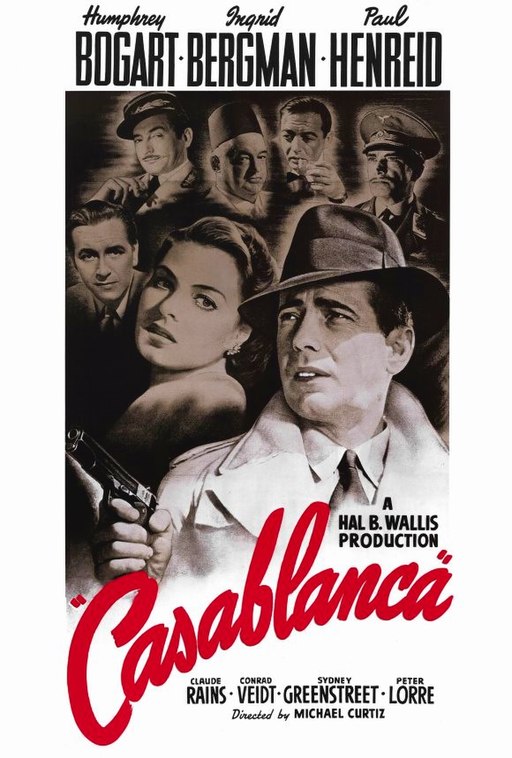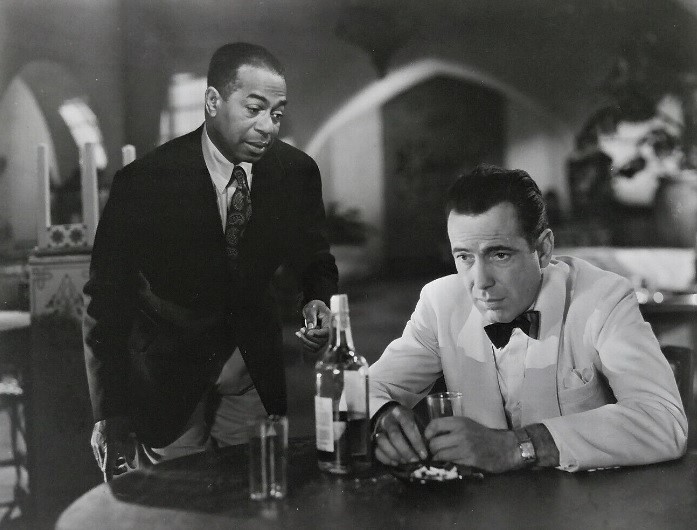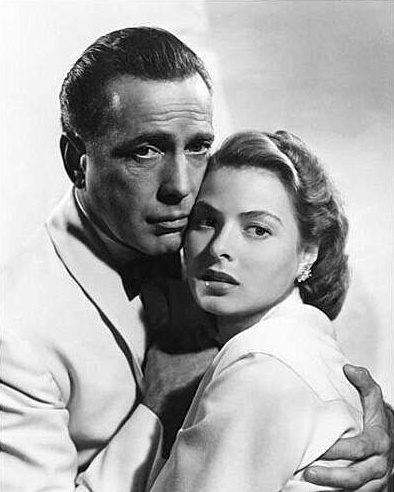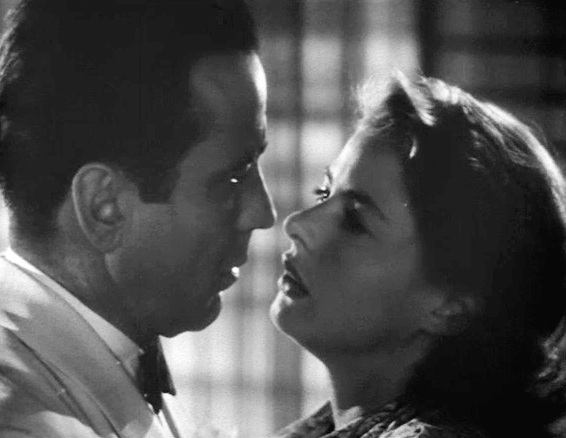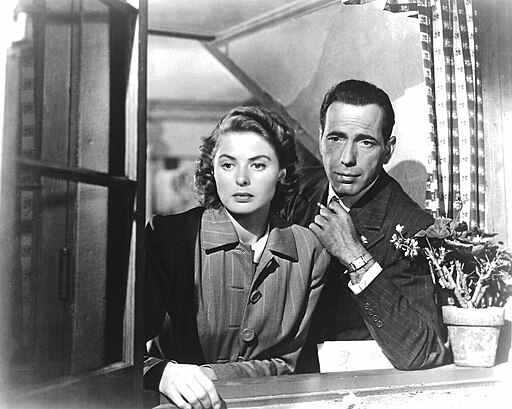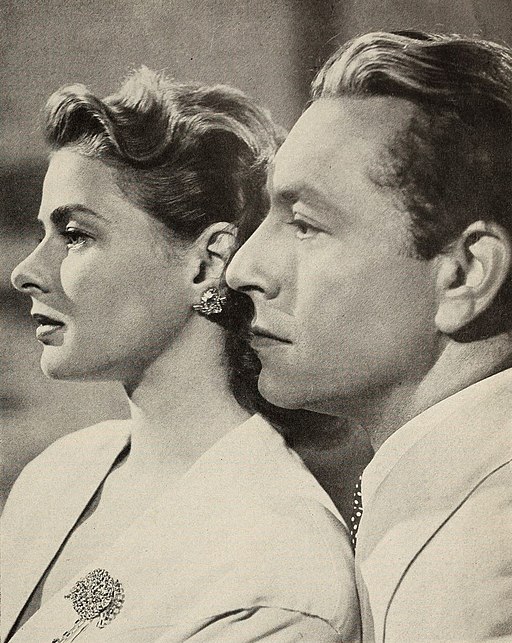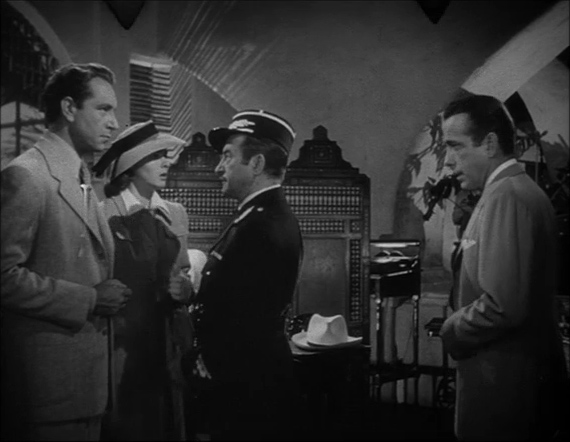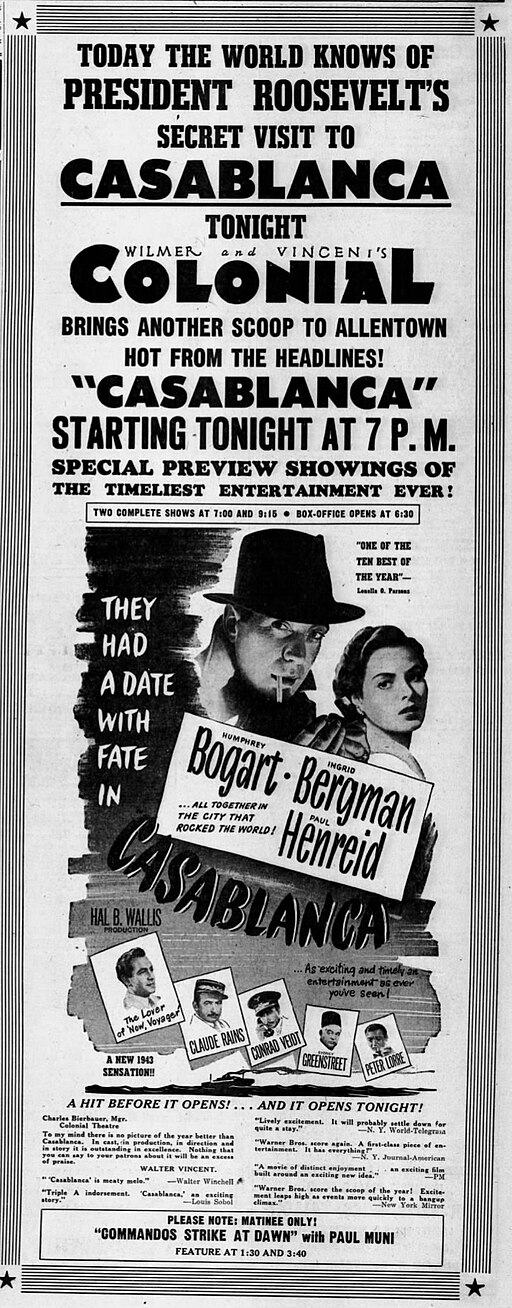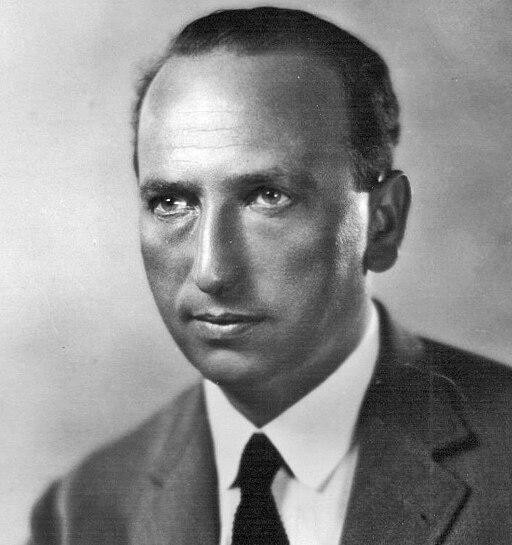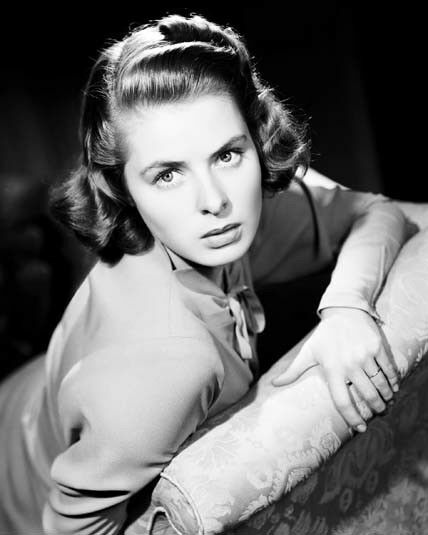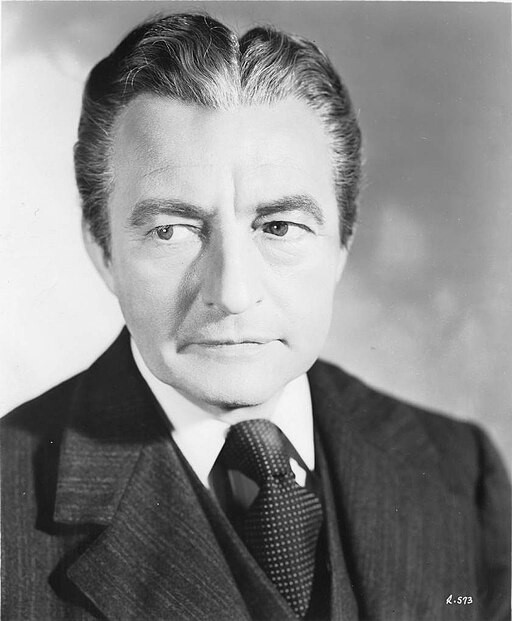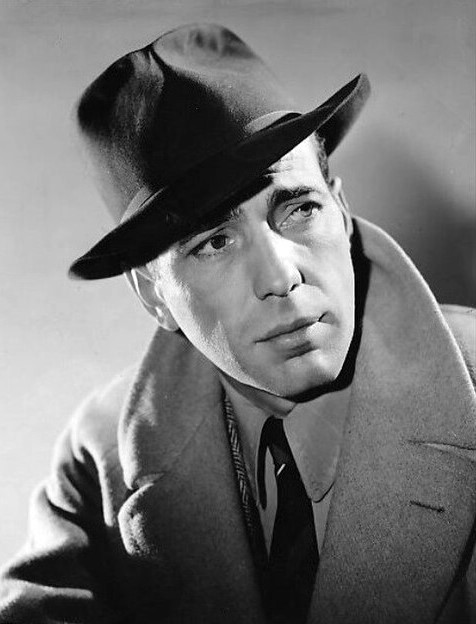Casablanca - 1942
back| Released by | Warner Bros. |
| Director | Michael Curtiz |
| Producer | Hal B. Wallis |
| Script | Julius J. Epstein, Philip G. Epstein, and Howard Koch, based on the unproduced stage play |
| Cinematography | Arthur Edeson |
| Music by | Max Steiner |
| Running time | 102 minutes |
| Film budget | $ 1,1 million |
| Box office sales | $ 10,5 million |
| Main cast | Humphrey Bogart - Ingrid Bergman - Paul Henreid - Claude Rains - Conrad Veidt - Peter Lorre |
Casablanca
A timeless tale of love and moral dilemmas
"Casablanca" is not just a film but a piece of cinematic history. It's celebrated for its memorable lines, romantic and moral complexities, and the timeless performances of its leading actors.
The film won three Academy Awards, including Best Picture, Best Director, and Best Adapted Screenplay, and continues to be a beloved and influential film in the history of cinema.
Related
Casablanca – 1942
Overview and Analysis
"Casablanca," released in 1942, is not only a landmark American film but also a cultural icon. Its story, characters, and dialogue have become an integral part of the fabric of cinema history. Here's a detailed summary and analysis:
Summary
Setting: The film is set in the early days of World War II in Casablanca, a city in French Morocco. Casablanca is portrayed as a place of transit, filled with refugees desperate to escape the Nazi regime.
Plot: At the heart of the story is Rick Blaine (Humphrey Bogart), an American expatriate who owns a popular nightclub, "Rick's Café Américain." Rick is depicted as cynical and non-political, but his past harbors a deep hurt from a failed romance in Paris with Ilsa Lund (Ingrid Bergman).
Ilsa re-enters Rick's life when she arrives in Casablanca with her husband, Victor Laszlo (Paul Henreid), a Czech resistance leader. They seek transit papers to escape to America, which leads them to Rick's café, the center of various intrigues involving transit papers, corrupt officials, and the local police chief, Captain Louis Renault (Claude Rains).
The film's narrative revolves around the emotional turmoil experienced by Rick upon seeing Ilsa again, the moral choices he faces, and the political undertones of war and resistance. The climax occurs when Rick must decide whether to use the letters of transit he has obtained to escape with Ilsa, whom he still loves, or to help her and her husband escape, thus aiding the resistance against the Nazis.
Analysis
Themes: "Casablanca" explores themes like love, sacrifice, and moral ambiguity in a time of war. It adeptly combines personal drama with broader political issues, making it a compelling narrative of love and heroism.
Character Development: Rick's character arc is central. He evolves from a disillusioned and self-serving individual to someone who makes a significant sacrifice for a greater good. Ilsa's character adds complexity to the love story, as her feelings for Rick conflict with her commitment to Victor and the cause he represents.
Symbolism: The film is rich in symbolism. Casablanca itself symbolizes a purgatory of sorts, where various characters await their fate. The letters of transit represent freedom, a coveted and rare commodity during the war.
Cinematic Techniques: Directed by Michael Curtiz, the film uses lighting, shadows, and close-ups to enhance the emotional depth and the noir atmosphere. The cinematography by Arthur Edeson contributes significantly to the film's moody and romantic ambiance.
Music: Max Steiner's score, particularly the song "As Time Goes By," played by Sam (Dooley Wilson), is integral to the film’s emotional and narrative structure. It reinforces the themes of lost love and the passage of time.
Cultural Impact: "Casablanca" has left a lasting legacy in film history. Lines like "Here's looking at you, kid," and "We'll always have Paris," have become ingrained in popular culture. The film’s blend of romance, intrigue, and moral dilemmas, set against the backdrop of a world at war, has continued to resonate with audiences over the decades.
In summary, "Casablanca" is a masterful blend of romance, suspense, and wartime drama, with rich characterizations and a story that captures the complexities of love and sacrifice. Its legacy endures as a testament to the enduring power of storytelling and cinema.
Trailer of Casablanca:
Full Cast of “Casablanca”:
- Humphrey Bogart as Rick Blaine
- Ingrid Bergman as Ilsa Lund
- Paul Henreid as Victor Laszlo
- Claude Rains as Captain Louis Renault
- Conrad Veidt as Major Heinrich Strasser
- Sydney Greenstreet as Signor Ferrari
- Peter Lorre as Ugarte
- S.Z. Sakall as Carl (as S.K. Sakall)
- Madeleine Lebeau as Yvonne (as Madeleine LeBeau)
- Dooley Wilson as Sam
- Joy Page as Annina Brandel
- John Qualen as Berger
- Leonid Kinskey as Sascha
- Curt Bois as the pickpocket
Analysis of the Direction of Michael Curtiz:
Michael Curtiz's direction in "Casablanca" is a testament to his versatility and skill as a filmmaker. His work on this film showcases several key aspects of his directorial style and his ability to weave complex narratives into compelling cinema. Here's a detailed analysis of his direction:
Visual Storytelling
Curtiz was known for his strong visual sense, and this is evident in "Casablanca." He used lighting and composition to enhance the mood and underscore the film's themes. The use of shadows and light contrasts adds a noirish quality to the film, creating an atmosphere of mystery and intrigue that is fitting for the story's setting and the era's tension.
Pacing and Rhythm
Curtiz's handling of the film's pacing is masterful. "Casablanca" moves at a brisk pace, with a balance of dialogue, action, and quieter, more introspective moments. This pacing keeps the audience engaged and contributes to the building of tension throughout the film, especially in scenes involving the threat of Nazi interference and the emotional interplay between Rick, Ilsa, and Laszlo.
Character Development
One of Curtiz's strengths in "Casablanca" is his direction of actors and his focus on character development. Each character in the film, from Rick Blaine to the minor roles, feels fully realized. Curtiz's direction allowed actors like Humphrey Bogart and Ingrid Bergman to deliver some of their most memorable performances. He guides them through a range of emotions, from cynicism and despair to love and sacrifice, bringing depth to the narrative.
Thematic Expression
Curtiz adeptly weaves the film's various themes, including love, sacrifice, and moral ambiguity, into a cohesive whole. He never lets the romantic elements overshadow the broader political and social implications of the story. This balance gives "Casablanca" its enduring power and relevance.
Use of Music
Curtiz's use of music, particularly the song "As Time Goes By," is integral to the film’s emotional impact. He understood the power of music in cinema and used it to enhance the story's romantic and nostalgic elements. The scenes in Rick's café with Sam playing the piano are not just memorable for their dialogue but also for how the music underscores the emotional undercurrents.
Collaboration
Curtiz was known for his ability to collaborate effectively with other creatives. In "Casablanca," this is evident in his work with the screenwriters, cinematographer Arthur Edeson, and composer Max Steiner. This collaboration helped to create a film that is greater than the sum of its parts, with each element complementing the others.
Conclusion
In "Casablanca," Michael Curtiz's direction is a blend of technical mastery, narrative skill, and emotional depth. He creates a film that is not only visually striking and narratively engaging but also rich in thematic complexity. His work on this film is a prime example of his talent and a significant contribution to the art of cinema.
Analysis of Humphrey Bogart’s Performance as Rick Blaine:
Humphrey Bogart's portrayal of Rick Blaine in "Casablanca" is not only iconic but also a defining role in his career, showcasing his immense talent and charisma. His performance as Rick is multifaceted, adding layers of complexity to a character that could have easily been a standard leading man in a wartime drama.
Character Complexity
Rick Blaine is a character of contradictions. He is a cynic, yet he has a heart; he appears indifferent, yet he is deeply emotional. Bogart masterfully captures these nuances, creating a character who is both enigmatic and relatable. His Rick is a jaded nightclub owner who claims to be neutral and uninvolved, yet his actions and past reveal a man capable of great love and sacrifice.
Screen Presence and Charisma
Bogart's screen presence is undeniable. He exudes a cool, understated charisma that is compelling and attractive. His portrayal of Rick is both tough and tender, often in the same scene. This duality adds depth to his character and keeps the audience engaged, wondering what he will do next.
Emotional Range
Throughout the film, Bogart displays an impressive emotional range. In scenes with Ingrid Bergman's Ilsa, he conveys a profound sense of hurt and betrayal, yet also shows a lingering affection. In moments where he interacts with other characters, like Claude Rains' Captain Renault or Paul Henreid's Victor Laszlo, he shifts effortlessly from sardonic wit to seriousness, indicating Rick's complex inner life and moral compass.
Physicality and Expression
Bogart's physicality and facial expressions add layers to his performance. He uses subtle gestures and looks to convey what Rick is thinking and feeling, often without words. His ability to express cynicism, amusement, or sadness with just a slight change in expression or posture contributes significantly to the character's depth.
The Anti-Hero
Rick Blaine can be seen as an anti-hero; he is not the typical upright, morally unambiguous protagonist. This kind of role was a perfect fit for Bogart, who had a knack for playing complex characters with a hard exterior but a vulnerable interior. His Rick is a man who has been hardened by life's disappointments but still retains a sense of decency.
The Romantic Lead
Bogart's role as a romantic lead in "Casablanca" was somewhat unconventional for the time. He was not the typical Hollywood heartthrob; his appeal lay in his rugged authenticity and understated charm. His chemistry with Bergman is palpable, making their doomed romance one of the most memorable aspects of the film.
Legacy
Humphrey Bogart's portrayal of Rick Blaine is a significant part of his legacy as an actor. It showcases his ability to imbue a character with complexity and humanity, making Rick a timeless figure in cinema history. The role contributed significantly to Bogart's status as a cultural icon and one of the greatest actors in film history.
Filming Location of Casablanca:
"Casablanca," despite its setting in the Moroccan city, was primarily filmed in Hollywood, California, on the sound stages of Warner Bros. Studios. This is a key aspect of the film's production:
- Warner Bros. Studios in Burbank, California: The majority of "Casablanca" was shot inside Warner Bros. Studios. The studio's backlot was effectively used to create the illusion of the exotic, bustling city of Casablanca. This included sets for Rick's Café Américain, the streets of Casablanca, and the airport scenes.
- Use of Sets and Backdrops: The film utilized detailed sets and backdrops to create the ambiance of Casablanca. The production design, although not filmed on location in Morocco, successfully evoked the feel of a North African city under French colonial rule during World War II.
- Rick's Café Américain: One of the most iconic sets in the film is Rick's café, which was entirely a studio creation. The set was designed to give a sense of a stylish, slightly run-down nightclub that would be a melting pot for the various characters in the film – refugees, Nazis, Vichy French officials, and others.
- Van Nuys Airport: The final airport scene, a crucial part of the movie, was filmed at the Van Nuys Airport in Los Angeles. The scene was shot at night with a heavy use of fog to help mask the fact that it was not an actual large, active airport.
- Limited Outdoor Filming: While most of the film was shot on sound stages, there were a few outdoor shots. However, none of these were filmed in the actual city of Casablanca. They were carefully crafted to match the indoor sets and maintain the film's visual consistency.
- Filming During World War II: It's important to note that "Casablanca" was filmed during World War II. The ongoing war made it impractical and unsafe to film on location in Morocco.
The choice to film in Hollywood was typical of the era's studio system, where controlled environments allowed for greater artistic and technical control. This approach was particularly important for a film like "Casablanca," where the atmosphere and setting were key elements of the story. Despite not being filmed on location, the movie convincingly transports audiences to its wartime setting, demonstrating the effectiveness of the set design and the filmmaking techniques of the period.
Analysis of Ingrid Bergman’s Performance as Ilsa Lund:
Ingrid Bergman's portrayal of Ilsa Lund in "Casablanca" stands as a poignant and deeply nuanced performance, showcasing her remarkable talent and screen presence. Bergman brought a complex emotional depth to Ilsa, making her one of the most memorable characters in cinematic history.
Emotional Complexity
Ilsa Lund is a character who embodies emotional complexity and inner conflict. Bergman's portrayal is rich with nuance, capturing Ilsa's torn feelings between her love for Rick (Humphrey Bogart) and her duty to her husband, Victor Laszlo (Paul Henreid). She conveys a sense of melancholy and longing that is palpable, adding layers of depth to the love story at the heart of the film.
Subtlety and Restraint
Bergman's performance is marked by subtlety and restraint. She communicates Ilsa's emotions often through subtle gestures and expressions rather than overt drama. This understated approach makes her character more relatable and authentic. Her ability to convey profound feelings with a glance or a slight change in expression adds a powerful emotional dimension to the film.
Chemistry with Co-Stars
The chemistry between Bergman and Bogart is one of the defining elements of "Casablanca." Her interactions with Bogart are charged with a mix of passion, nostalgia, and sorrow. This chemistry is crucial in making their relationship believable and deeply affecting. Similarly, her scenes with Paul Henreid, who plays her husband, effectively convey a different kind of love, one based on respect and shared ideals.
Symbolism and Representation
Ilsa Lund's character can be seen as a symbol of the challenges and moral dilemmas faced by individuals during wartime. Bergman imbues Ilsa with a dignity and grace that transcend the personal tragedy, making her a representation of the broader human experience during World War II. Her choices in the film reflect the difficult decisions that many had to make during this tumultuous period.
Strength and Vulnerability
Bergman portrays Ilsa as both strong and vulnerable. She is a woman who, despite being caught in a complicated and dangerous situation, exhibits resilience and courage. Yet, her vulnerability, especially in her love for Rick, makes her a more sympathetic and compelling character. Bergman's ability to balance these aspects gives Ilsa a multi-dimensional quality.
Legacy
Ingrid Bergman's role as Ilsa Lund contributed significantly to her legacy as an actress of extraordinary depth and ability. Her performance in "Casablanca" remains one of her most celebrated roles, showcasing her skill at portraying complex characters with emotional authenticity. Ilsa Lund, as brought to life by Bergman, remains a symbol of love, strength, and sacrifice in cinematic history.
Memorable Quotes from “Casablanca”:
"Casablanca" is renowned for its memorable dialogue, featuring some of the most iconic lines in film history. Here are several important quotes from the film:
- "Here's looking at you, kid." - Rick Blaine (Humphrey Bogart)
- This line, delivered by Rick to Ilsa, is one of the most famous in cinema. It's a tender and affectionate phrase that encapsulates their complicated relationship.
- "We'll always have Paris." - Rick Blaine
- Rick uses this line to remind Ilsa of their time together in Paris, a period of happiness before the war changed everything.
- "Of all the gin joints in all the towns in all the world, she walks into mine." - Rick Blaine
Rick says this when Ilsa first comes to his café, expressing his shock and the seeming improbability of their reunion.
- "Play it, Sam. Play 'As Time Goes By'." - Ilsa Lund
Often misquoted as "Play it again, Sam," this line is Ilsa's request to hear a song that holds great significance to both her and Rick.
- "I think this is the beginning of a beautiful friendship." - Rick Blaine
Spoken by Rick to Captain Renault at the end of the film, this line signifies a shift in their relationship and Rick's changed perspective.
- "Round up the usual suspects." - Captain Renault
This line is used by Renault to cover up for Rick's actions and indicates his decision to align with Rick against the Nazis.
- "If that plane leaves the ground and you're not with him, you'll regret it. Maybe not today. Maybe not tomorrow, but soon and for the rest of your life." - Rick Blaine
Rick says this to Ilsa, convincing her to leave with Laszlo for the greater good, despite their love for each other.
These quotes are not only memorable for their wording but also for how they encapsulate the themes of love, sacrifice, and moral complexity that run through "Casablanca." They have become ingrained in popular culture and continue to resonate with audiences today.
Awards and Recognition:
Academy Awards (Oscars)
1943 Academy Awards:
- Best Picture (Won)
Awarded to Hal B. Wallis, the producer of "Casablanca."
- Best Director (Won)
Michael Curtiz for "Casablanca."
- Best Writing, Screenplay (Won)
Julius J. Epstein, Philip G. Epstein, and Howard Koch for the screenplay of "Casablanca," based on the play "Everybody Comes to Rick's" by Murray Burnett and Joan Alison.
- Best Actor in a Leading Role (Nominated)
Humphrey Bogart for his role as Rick Blaine.
- Best Actor in a Supporting Role (Nominated)
Claude Rains for his role as Captain Louis Renault.
- Best Cinematography, Black-and-White (Nominated)
Arthur Edeson for "Casablanca."
- Best Film Editing (Nominated)
Owen Marks for "Casablanca."
Other recognitions:
- American Film Institute (AFI): "Casablanca" has been consistently ranked high on the AFI's lists, including their "100 Years... 100 Movies" lists, celebrating the greatest movies in American cinema.
- National Film Registry: The film was selected for preservation in the United States National Film Registry by the Library of Congress as being "culturally, historically, or aesthetically significant."
- Various Retrospective Awards and Honors: Over the decades, the film has been honored at various film festivals and by film critics' circles as a retrospective acknowledgment of its impact.

